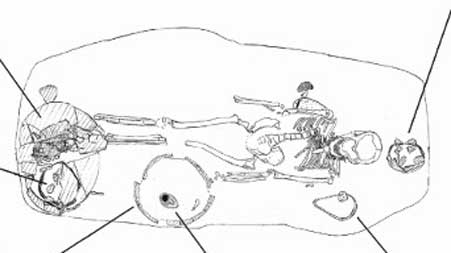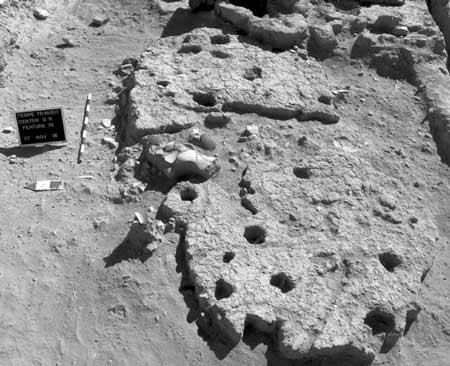“There’s more that we can say about these people besides, they lived, they died, and this is where they were put. By looking at [the buried person’s] deformities and maladies and everything she went through in life, it says a lot more about the community in which she lived, than what she struggled with.” – Eric Cox, lead archaeologist on the excavation of Burial 167.

PHOTO: westerndigs.org
TEMPE, ARIZONA – a recently discovered grave near Tempe, Arizona, is giving archaeologists and regular people a glimpse into the complex and compassionate culture that once lived in the area more than 800 years ago.
Archaeologists were called in to downtown Tempe, Arizona in 2006 to record, organize, and preserve 172 buried and cremated remains found in a large area of the city center. Workers stumbled across the burial ground while attempting to put in a light rail system for the city. What resulted was the discovery of a 13th century community of the Hohokam culture. The Hohokam were best known for their knowledge in engineering. They constructed a vast network of canals to irrigate their home in the Phoenix valley.
One burial has caught the researchers’ eyes. It’s a complete skeleton of a 20-year-old woman, and her story is capturing the minds and hearts of the world.
When the archaeologists began studying her remains, two things caught them by surprise. Her skeleton was severely disfigured, and her grave was one of the richest of all the 172 graves on the site. This raised several questions for Eric Cox, the lead archaeologist on the dig.
“I was actually digging that one, and it was toward the end of the day when we started to uncover it,” Eric Cox said, “I got her skull uncovered, and I got to her left side, and … what stuck out to me was that her entire left side was gracile — it hadn’t developed as much as the right side had. It was like her left side was for a five-foot person, while her right side was for a five-foot-six person.”
As he examined the remains further, more complications began to arise. It was clear that the woman had a severe case of scoliosis. At one point in her spine, at the base of her skull, her spine curved at an angle of 55 degrees. The woman also had discoloration in her skeleton, too, which is a sure sign of rickets. Rickets is caused by a lack of Vitamin D. This disease usually occurs when a person isn’t getting enough sun.
There was one more complication, as if the others weren’t enough. The woman also had lesions on her skull and spine. These lesions would have been caused by an extreme case of tuberculosis. The disease, when fully progressed, spreads from the lungs into bone tissue.
Eric Cox pieced it all together. The woman probably was born with scoliosis. As the malady worsened, she would be bedridden and forced to stay inside, which would then lead to not getting enough sun, and thus rickets.
“You wouldn’t think rickets would be a problem here in the Southwest where there’s plenty of sun,” Cox said. “So part of what we were thinking was that she didn’t get any sun exposure because she was kept in her dwelling, which makes sense with the curvature of her spine, because if she could have walked, it would’ve been really painful.”
These complications all worked against her, and, eventually would have made her prone to infections like tuberculosis.
Now, the question remained – how could a woman with so many health problems survive to the age of twenty during the twelfth century, when infant mortality rates were high, and deformed infants often abandoned? Well, the answer lies in two more clues: her diet, and the culture she belonged to.
This woman belonged to the Hohokam. The Hohokam had a diet that was primarily made up of maize, a cornlike, gritty starch. The maize would first have to be ground on stones. During the process, sand from the worn grinders would mix with the maize flour, causing severe damage to a person’s teeth. Human remains throughout the American Southwest all display this trait.
…Except for our burial at Tempe. Her molars and teeth are perfect.
Why?
Apparently, somebody was feeding her a specialized diet.
Cox speculated that her diet was so specialized, in fact, that it led to malnutrition, which would have only exacerbated her illnesses. But, was it a sign of neglect, or something else?
“There are ethnographic accounts of people with deformities [being treated] in a ritual context like shamans,” Cox explained, “Where they ate different foods than the other people did.”
If this is true, and the Hohokam people did revere this young woman as a shaman, then it would explain why her burial was one of the richest out of all of the ones at the site. The woman was buried with six ceramic items, a record for the burials at Tempe, only rivaled by a few other graves.
Here’s Eric Cox’s theory: he believes the woman was born with scoliosis. Because of this, the Hohokam believed she had special ritual powers or knowledge. So, they treated her differently from the others in the village – keeping her inside, feeding her a special diet.
“But they took care of her for decades,” Cox pointed out, “It wasn’t like she was taken out to a hill and left to die because she was never going to be a productive member. The community banded together and took care of this woman for her whole lifetime.”
Ritual aspect or no, the burial at Tempe is a wonderful example of the best of humanity. The people at Hohokam chose to compassionately care for this disabled woman in the best way they knew how. When she passed away, they buried her with the most expensive items they could give her, to ensure her afterlife would be better than her painful life here on earth.
“I think one of the most important things that we can get out of this, is that we can start looking at these less as burials and skeletons, and look at them more as people. They’re just the same as we are. They didn’t have air conditioning and motor vehicles, but their wants and their desires and the way they lived their lives were fairly similar, when you get down to the basics.” – Eric Cox.


